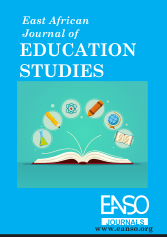Influence of Peer Pressure on Secondary School Students Dropout in Nanyamba Town Council, Mtwara, Tanzania
Abstract
School dropout is among the phenomena challenging youth to achieve education and related skills to make them competitive in today’s global economy. This study explored the influence of socioeconomic factors and the dropping out of secondary school students; the extent of school dropout; and established the strategies for overcoming the school dropout syndrome at Nanyamba Town Council. The study utilized a qualitative approach using a study sample which included five headmasters, five class teachers, five class monitors, one ward educational officer, one quality assurance officer and one headquarters officer. A semi-structured interview was used for data collection. Findings disclosed that socioeconomic factors lead to students dropping out of school due to a lack of awareness of the importance of education and illiteracy in families. Parents’ low income and cultural aspects such as early marriage and early pregnancy. Divorce, lack of family planning, negative attitudes towards education especially for girls and parents' deaths were also found to be the problems leading to school dropout. Among the recommendations given are: the provision of scholastic materials, the provision of lunch by schools, mass mobilization and the need to sensitize the community on education to make them aware of the importance of secondary education
Downloads
References
Barton, P. E. (2005). One third of a nation: Rising dropout rates and declining opportunities. Educational Testing Service.
Castillo, G. (2010). Teenagers and their problems. Forcus Publishers.
Creswell, J. W. (2002). Research design: Qualitative, quantitative, and mixed method approaches. Sage Publications.
Drewry, J. A. (2007). High school dropout experiences a social capital perspective. USA Blacksburg, VA.
Duflo, E., Pascaline, D. & Michael, K. (2010). Education, HIV and early fertility; Experimental evidence from Kenya MIT. Department of Economic working paper.
Kadau, I. (2023). Parental Involvement in the Implementation of CBC in Primary Schools. APLIKATIF: Journal of Research Trends in Social Sciences and Humanities, 2(2), 135-146.
Kadzamira, E. & Schiwana, P. (2000). Can free primary education meet? The needs of the poor? Evidence from Malawi. International Journal of Educational Development, 23.
Kalinga, T. S. (2013). Causes of drop-out in secondary schools in Tanzania: The case study of Mbeya, Dar es Salaam and Kilimanjaro regions [Unpublished master dissertation]. The Open University of Tanzania.
Mendes, P., Baidawi, S. & Snow P. C. (2014). Young people transitioning from out-of-home care in Victoria: Strengthening support services for dual clients of child protection and youth justice. Australian Social Work, 67(1), 6-23.
Mooney, L. A, Knox, D. & Schant E. (2007). Understanding social problems (5th ed.). Nebraska, Thompson Wadsworth.
Mudis, P. A. & Yambo, J. M. O. (2015). Role of peer counselling on the relationship between prefects and the student’s body in public secondary schools in Migori, sub-county, Migori County, Kenya. International Journal of Academic Research in Progressive Education and Development 4(4). 136, 149.
Mutwol, L. Cheserek, G., Boit, J. & Mining, P.J. (2012). Socio-economic factors influencing participation and dropout of students in public secondary schools in Marakwet District, Kenya [Unpublished M. Ed. thesis]. Kenyatta University.
Oetting, E. R. & Beauvais, F. (1987). Peer cluster theory, socialization characteristics, and adolescent drug use: A path analysis. Journal of Counselling Psychology 34(2), 205.
Oetting, E. R., Spooner, S., Beauvais, F. & Banning, J. (2012). Prevention, peer clusters and the paths to drug abuse. Persuasive Communication and Drug Abuse Prevention, 239-261.
Ombuya, B. D., Yambo, J. M. O&Mboya, O. T. (2012).Effect of orphan hood on girl-child’s access and retention in secondary school education: A case of Rongo District, Kenya. International Journal of Academic Research in Progressive Education and Development 1(4).
Reid, K. (2006). An evaluation of inspection reports on primary school attendance. Educational Research, 48(3), 267-286.
United Nations International Children Educational Fund. (2001). A situational analysis of orphans and vulnerable children and adolescent in Zimbabwe: Summary Report 20.
Yambo, J.M.O. (2012). Determinants of KCSE examination performance in SDA sponsored schools: A key to academic promotion to the next level of learning. Lambert Academic Publishing.
Copyright (c) 2025 Kulinga Issa Rashidi, Issa O. Malecela

This work is licensed under a Creative Commons Attribution 4.0 International License.




























